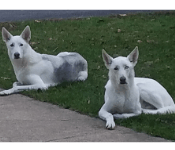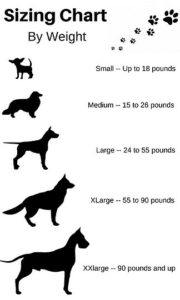As a dog owner, it breaks your heart at the idea that your best friend could be in pain and you don’t know it.
But dogs often hide their pain, it’s instinctive. Animals in the wild can’t show that they are hurting or weak because that puts them at risk with predators.
So if they don’t show it when something is wrong, how to know if your dog is in pain?
Here is a list of some things you can look for to give you a clue that your pooch is telling you something is wrong.
Decrease or Loss Of Mobility
 If your dog is limping or walking very stiffly, that’s a pretty obvious sign that he may have an injury or arthritis is setting in.
If your dog is limping or walking very stiffly, that’s a pretty obvious sign that he may have an injury or arthritis is setting in.
But some changes in mobility can be more subtle. He could be sleeping more than usual, not as active outside, avoiding walking up or down stairs, for example.
You’re working, taking care of the kids, the house, the yard–it can be very easy to miss these subtle signs that may indicate your dog is feeling pain.
Many times the symptoms get much worse before it’s recognized as something being wrong.
==>==> See How An Orthopedic Dog Bed Can Help Relieve Your Dog’s Pain <==<==
Restlessness
The other side of mobility issues is restlessness. Does your dog get up often to change positions or move to a new location? Does he move around a lot and not appear to be sleeping as much?
 When my children were younger, we had a beautiful Husky/Collie mix named Casey. She was a wonderful family dog who loved to be outside, no matter how cold it was.
When my children were younger, we had a beautiful Husky/Collie mix named Casey. She was a wonderful family dog who loved to be outside, no matter how cold it was.
When Casey was about 8 years old, I looked out in the backyard one morning and saw her oddly standing by our fence. I went out and tried to get her to come to me, but she wouldn’t.
Casey somehow couldn’t walk through a small bush in front of her and appeared to be in distress when she tried to back up. I pushed the bush aside and she slowly walked to the house.
Alarmed, I took her to the vet that afternoon. I was heartbroken when I was told that she had a small fracture in a vertebra in her back!
Thinking back, I realized that she had been restless for a couple of days and hadn’t been sleeping much. If I’d recognized this as a sign that she was in pain, I could’ve spare her so much.
She was given a cortisone shot to relieve the pain, and when we got her home, she slept for about 15 hours straight! Casey never so much as gave a whimper that whole time, but her restlessness was a clue that I’ll never forget.
==>==> CBD Oil for Dogs to Help with Anxiety, Pain, Mobility, and more <==<==
Negative Changes In Behavior
Is your dog showing signs of aggression that are very unlike him? Is he becoming antisocial or pulling away from people in a way that is unusual?
 Any change in behavior such as this can be from your dog protecting himself. For instance, a dog that is feeling joint pain may avoid playing with kids as much or may spend more time in another room away from the family.
Any change in behavior such as this can be from your dog protecting himself. For instance, a dog that is feeling joint pain may avoid playing with kids as much or may spend more time in another room away from the family.
Unusual aggression is often a sign that pain is making a dog keep someone at bay. About a year ago, our daughter’s dog, Chief, occasionally would give a very low growl when my 6 year-old grandson would sit by him.
This was extremely odd behavior because the 2 of them adored each other, and Chief would often go lay down with him on the couch or the floor.
But Chief had injured one of his back legs when he was a puppy, and as he got older, he suffered from arthritis in that leg.
My daughter recognized that Chief was showing his aggression whenever his leg was bothering him and my grandson was running around a lot. Chief was giving a warning because he was afraid of getting hurt by a rambunctious little boy.
Once she understood the situation, she was able to make her dog more comfortable and teach her son how to help care for him.
==>==> See The 5 Best Orthopedic Dog Beds For Large Dogs <==<==
Changes In Eating Or Drinking
Has your dog started to lose his appetite? Is he drinking more water than usual? Both of these are common signs that your dog could be having a problem.
A loss of appetite can be a symptom of a number of illnesses or diseases. But if your dog is avoiding eating, especially things like hard treats, it could also be from dental pain.
If your dog is drinking an unusual amount, there are several issues that could be causing him to lose excess amounts of water. Recognizing this common symptom can help you and your vet get started with a healing plan as early as possible.
Licking Excessively
 Has your dog started to groom himself much more frequently, such as licking his paws excessively? Or is he licking one point on his body a great deal that is abnormal?
Has your dog started to groom himself much more frequently, such as licking his paws excessively? Or is he licking one point on his body a great deal that is abnormal?
Not only is licking a way for dogs to clean themselves, it’s also how they try to comfort themselves when something hurts many times.
After our German Shepherd, Sasha, had surgery for her torn CCL in her leg, everything appeared to heal well. But a few weeks later she started to lick a spot on her leg so much that she actually created a sore.
When we took her back to get checked, the surgeon told us that a small percentage of dogs develop an allergy of sorts to the metal plate that’s used to keep the titanium rods in place as she healed.
As the plate was no longer needed, Sasha had another surgery to have it removed. All was well……or so we thought.
About 3 weeks after that surgery, she again started licking a spot on her leg, creating another sore. The vet suspected that she had a deep infection in her leg and wanted to be aggressive with her antibiotics to ensure that it healed fully.
After 2 rounds of antibiotic shots, Sasha’s leg was finally healed!
However, if she hadn’t shown us that she was in pain by licking her leg excessively, it would’ve gotten much worse before we knew something was wrong.
==>==> 8 Best Orthopedic Dog Beds Worth Your Money For Dogs Of All Sizes <==<==
Lumps Or Changes In Their Body
 Does your dog have an unusual lump, swelling, or change in their body? Many times these can appear in a place where your dog can’t lick or show you that they have any discomfort.
Does your dog have an unusual lump, swelling, or change in their body? Many times these can appear in a place where your dog can’t lick or show you that they have any discomfort.
Our beautiful Black Labrador, Malcolm, was 13 when I found a small lump by his throat. He loved laying on the couch with one of us and having his head and neck stroked, so I knew the lump wasn’t normal.
Our vet verified that it was most likely a Basel cell cancer that wouldn’t be possible to remove, and Malcolm was too advanced in age to put him through a surgery anyway.
Since we found it early, we were able to have him for 6 more months before the day came when we knew it was time to let him go.
Changes In Vocalization
Just like a parent recognizes the different cries their baby makes, a dog owner knows the different barks and vocalizations their dog makes.
So if your dog is barking, growling, yelping, etc., in a way that is out of character at times, that could be a sign that they may be hurting somewhere.
Remember, it’s instinctive for a dog to hide pain and vulnerability. But unusual sounds or changes in their barking could be a clue that you need to look closer for a sign of discomfort.
Unusual Shaking Or Trembling
 Shaking or trembling when a dog is cold or nervous is totally normal.
Shaking or trembling when a dog is cold or nervous is totally normal.
In fact, at our last vet visit there was a small dog who just trembled uncontrollably as soon as they brought him in the door and completely stopped the second they walked him out. The poor baby was just scared to death of going to the vet!
But if you see your dog shaking without an obvious reason, they could definitely be in pain, and you need to check it out.
It’s possible that they got into something poisonous or that they ate a large amount of something that can be harmful to dogs, like chocolate, for example.
Some diseases or infections can also make a dog shake or tremble, such as pancreatitis.
Changes In Breathing
Just like any of us, if a dog has been very active or is hot, they are going to pant, and it’s totally normal.
But if you notice your dog panting heavily when there doesn’t appear to be a reason, you need to look closer. This could be a sign that they are in distress or in pain somewhere.
On the flip side, if your dog’s breathing appears shallow or labored, they could be having trouble getting enough air and need to be checked out right away.
==>==> See how CBD Oil can help with your Dog’s Mobility, Pain, Anxiety, and more <==<==
Posture And Stance Changes
 Is your dog standing very rigid or stretching himself out a lot? This is a common sign of intestinal discomfort.
Is your dog standing very rigid or stretching himself out a lot? This is a common sign of intestinal discomfort.
Our male German Shepherd, Tahlen, loves to chew on scraps of wood from our woodpile. No matter how many times we take them away from him, he loves to sneak up and steal a small piece of wood and play Keep Away with Sasha.
However, every once in a while he gets an upset stomach from it, which means we have a mess to clean up!
We’ve recognized that whenever his stomach is upset, he stands very still and rigid for a few minutes. That’s enough time for us to get him outside and keep an eye on him to be sure there’s nothing else going on.
Some dogs will lay with their paws crossed and their bottom in the air as a way to stretch out and relieve discomfort.
Just like humans, intestinal distress is usually just temporary. But if you see your dog doing these things excessively, it may be time to suspect something else is going on.
Shaking Head/Scratching Ear
 We all have seen dogs shake their head or scratch their ear occasionally. But if your dog starts doing them a lot, he could have an ear infection or a yeast infection in the ear.
We all have seen dogs shake their head or scratch their ear occasionally. But if your dog starts doing them a lot, he could have an ear infection or a yeast infection in the ear.
Anyone whose dog has had one of these ear infections knows just how uncomfortable and downright painful they can be for them!
From experience with our dogs, the sooner you can identify that their head shaking and ear scratching could be signaling a problem, the better. Having your poor pooch keep you up all night with him crying and shaking his head from the pain isn’t fun for anybody!
==>==> How To Treat A Yeast Infection In Your Dog’s Ear <==<==
Get To Know Your Dog Well
All the things I’ve listed above are ways that your dog could be telling you that he’s uncomfortable or in pain.
But in my experience, the very best way you can help your dog is to pay attention and be aware of what is normal and typical behavior for your particular pooch.
Something could be totally normal behavior for other pets you’ve had or someone else’s dog. But if it’s unusual for your dog, take notice and look to see if he’s telling you that something’s just not quite right.
I learned that lesson the hard way with Casey and her back injury–no matter how busy I was with kids and work, I could’ve helped her so much sooner by paying attention to the signs that were in front of me.
Do you have any other signs or tips that you’ve seen for how to know if your dog is in pain? I’d love for you to share them with us in the comments below!
And don’t forget…..







Hello again Janelle! Thank you very much for sharing this article on how to know if your dog is in pain. It’s true that whenever my dog is in pain, my heart breaks because it’s hard seeing your best friend pass through pain. Sometimes, I wish Rex can talk to me about what he’s passing through but animals can’t talk and it’s really sad. After going through this 11 signs, I’m sure I’ll know any time my best friend is passing through pains and take care of it as soon as possible, thank you Janelle.
I don’t know how many times I’ve looked into a dog’s eyes wishing that they could tell me what they’re feeling. But since they can’t, all I can rely on is the signs they show and hope that I catch them early. I’m sure that Rex is in good hands with a loving owner like you!
Thank you for Shari g these ones here. Honestly, it can not be more better than the things you shared here. Being an adoptive parent of a dog, the last thing you want is your dog being in pain as it will be very feasible in their character traits and all nd this can have adverse effects in how they behave too. Thanks for sharing the rips on what to look out for. Really helpful here
I’m glad you found the information helpful, and thanks for taking the time to share your thoughts!
Most time we don’t pay close attention to our dogs and so even when they are in pain we don’t notice it at all. However in some, cases, we may be paying attention but may not know our dog is in pain. This article would be of great importance for anyone who takes the time to read through it properly. Nice information
The most important thing I’ve learned from having dogs all of my life is to pay attention to their habits and know what’s normal and what’s not. Thanks for stopping by!
Wow! How naive I have been towards my dogs. Well, it is still good that I cane across this today as I could be more aware towards other things that they would display henceforth. I value this infomation here and I have them jotted down to ensure I can actually stick with them all. Thank you so much for sharing here
I’m so glad you found the information helpful!
Hello Janelle, it’s really important to have a full knowledge of what one wants to go into before you go into it or you’ll be left banging or causing pain to your pet. Some people do not knowhow to identify pain in their own dogs and that’s really bad because you expose them to danger l. I have learned a lot from this post and I feel it’s time to start making prep to adopt a dog
Nothing is worse than realizing your dog has been in pain and you failed to recognize it. I’m glad you found the info helpful, and good luck in the search for your new best friend!
As a peer owner, it’s very important for us to know what and how our pets are feeling at all times, it’ll make it very easy for us to know how to better their health conditions and know if they are in pain easily. I’m so happy for these signs , it’ll be very resourceful and helpful to me as a dog owner.
Glad you found it helpful!
Hello there Janelle, I really enjoyed reading and learning from your article. I think it’s important to always monitor your dog’s health and to know how to properly take care of them and as someone who is new to the whole dog adoption and caring for process, coming across your article was a true blessing
I’m so glad you found it helpful!
Oh! A lot of times I have really not taken consideration of these signs and honestly, I feel like a very bad parent right now. However, the best time to get started was before ajfthe second best time is now. Thank you for sharing this here. Really well worthy. I’d try to be more attentive and also try to make the diffenrece more. Thanks
I can very much relate since almost everything I’ve learned is from experience. It’s been heartbreaking to realize that there were signs that I missed that could’ve helped my darlings sooner and keep them from feeling pain any longer than they had to. The saying that knowledge is king has never been more true than when dealing with the health of a loved one!
Hi Janelle, Thanks for such a comprehensive article on the many signals our pets may be trying to communicate with us. It is our job to pay attention to their signals and take care of their needs. We need to know what is normal and what means that something is wrong. Then we can get it dealt with to put our pet back into health.
I totally agree, knowing what’s normal with your pet can be the biggest advantage you have in detecting a problem early!
I had a pet dog that suddenly got sick. At first, I didn’t understand, but later I saw some of its behavioral negatives. That helped me understand my pet dog is in pain. I have read and enjoyed your article so I would like to share it with my friends by sharing it in the Facebook group so that my friends and family know the signs to look for.
I’m glad you found the information helpful!
I do not have a dog, but most of my friends do. Reading your article I came to think of some situations where my friends dogs actually might have been in pain. I think dogs are much like us humans. We are showing our pain in different ways. I will send your article to all my friends who have a dog, because I think they might find your article very helpful.
Thank you, and I hope they find it helpful!
Hey Janelle! Thank you for your comprehensive article on knowing the signs of when dogs are in pain. I too share a home with my doggo. He is a very street smart and knows how to act well. But I agree with your article that one of the signs where they have a negative change in behaviour shows they are somehow in pain, where aggression or avoiding playtime could mean something is not right with my pet’s physiological or psychological character.
Thank you for providing such useful information and I hope it helps all owners and animal lovers understand animals better!
You’re welcome, and I’m glad you found it helpful!
Thank you for posting this “How to know if your dog is in pain”. It really gave me an idea on how to be keen in observing how they act and release their feelings through sounds.
I learned to love dogs this turn to the 21st century. Prior to that time, I was one of the persons who love to eat dog meat. I now consider the dog as a member of the family and if I eat they should have something to eat too.
I would say that this article is really helpful to anyone who has dogs and it guides them to address immediate whatever pain their dogs have.
So glad your dogs are now part of the family, lol!
I must say that this is a great deal of information that you have shared with us on this article.as we all know dogs are closest animals to man,and as animals has been created they don’t have the ability to speak they only give you signs and make sound to pass information.thanks for sharing this 11 signs I would be on the watch as I have never experienced any one because my dog has never been in pain that I observed.
Hopefully these signs will be helpful to spot any signs of pain your pooch may experience as he gets older. Thank you for taking the time to share your thoughts!
Thank you very much for this post. I have seen Sparky different these days. I know he must want to tell me something but before reading your post I couldn’t guess what it was. I have seem him licking excessively and restless. But now I know he must be in pain. I think I should get him to the vet soon! Thanks again.
You’re welcome! If in doubt, a trip to the vet is always the best thing to do.
I wish sometimes my Shiro can talk so he can let me know when he is sick or he is in pain or he is being a drama queen. Thank you for sharing these 11 signs, I can really keep them as a reference next time. I have to keep a close eye on shaking his head or scratching his ears, I thought he is just itchy but you are right that is one sign as well. He also likes to lick a lot too. Will keep these in mind, I think it is best if I consult with my vet as well.
Cheers!
I’ve often said that I wish my dogs could talk and tell me what they’re feeling. But getting to know your dog well and recognizing when something is different is one of the best ways we can help them. If there’s any question or doubt, consulting with your vet is always best!
Hi Janelle,
Although we have a dog in our home I am not aware of many of these signs. I felt bad and this article is exceptionally rich in information!
I never ever thought licking and scratch their ear is a problem. This article is going to help in reducing pain for many dogs and hats off to you.
I learned a lot of useful things and the next time I see any of these signs in our dog I will pay close attention and it will result in taking care of him as early as possible.
I’m so glad you found the information helpful, and appreciate you taking the time to share your thoughts!
Thank you for all the information! It is definitely often times difficult to tell if your dog is having some health problems unless you know their regular habits really well. Many of the things you listed such as restlessness and scratching head and ears sound like regular dog habits to most people I would think, and most people would probably not think it’s any concern. I’m going to pay attention to all the signs you listed and monitor my dog more closely.
You’re exactly right, many of the things that can signal something concerning aren’t really noticed until the problem has gotten worse. But by paying attention to what’s normal behavior for your dog, you can spot something early if a behavior is out of character.
It is very true that dogs are very instinctive and they tend to hide their pains from their owners, i think this is because of their nature, they don’t like to bother you, rather they try to lighten your mood. Its good a dog owner to be able to detect if something is wrong with you pet, I appreciate this info, it’s very useful and will be helpful, they are practical signs.
I’m glad you found it helpful, and thank you for stopping by!
Hello Jannelle. I found this post very informative, useful and life saving in favour of our peace, happiness and the secure living of our dogs. Our dogs being in pain without us being aware or detecting the signs could lead to casualties, excessive spendings to bring the situation to light and if we fail due to late discovery of the pain, it could probably lead to deaths.
You seem to have a lot of experience as you have encountered most of these signs in previous times.
Thanks for sharing these 11 signs.
Regards!
I come from a long line of dog (and cat) lovers and have had dogs my entire life. I just wish that I had known about some of these signs sooner with dogs I had when I was younger.
Thank you for taking the time to stop by and share your thoughts!
Hey Janelle, Thanks for lighting on the signs to know that our dog is in pain. Your signs guide is awesome. We better understand about our dog with the help of signs you provided and try to resolve their pain as soon as possible. Before shorting out pain we must have knowledge about what to look for. Thanks and I will share it with my friends that have dogs. Parveen
Knowing your dog’s normal behavior and how to spot the first sign that something could be wrong is paramount to keeping your dog healthy and pain free. Thank you for taking the time to share your thoughts!
Hello Janelle, behaviors in our pets differ from one another, but these are surely some very common things I find different dogs doing regardless of their breed. Having a close on your let’s and being able to identify when they are in pain would be good for both the pets and its owner because we are saving ourselves the pain of possibly losing a pet, and most importantly, saving our buddy from pain. Best regards.
Keeping a close eye on your pet’s behavior is definitely easier when you have an idea of what to look for. You’re exactly right when you say that saving them from pain also saves us the pain of possibly losing them.
Thank you for taking the time to share your thoughts!
Thank you SO MUCH for giving us these 11 signs to watch out for. I totally agree with you that we need to pay attention to our pets and know them very well to see if something abnormal is happening. Our beloved pets are certainly worth it. It’s also interesting how a dog can sense an injury in a human. Just a while back I had to have surgery and my dog constantly licks me right where the healing incision is.
It’s so amazing what dogs can do! From what I understand, there are dogs that can even detect diseases like cancer in a human. They certainly prove themselves to be man’s best friend!
This is a very good post and helpful one too. There are some signs here that my pet tends to show but I didn’t know that it was a sign of being ill. One of those is his licking. Recently, he picks all too often which I find to be a very sad thing. I didn’t know that it was a sign and so I was looking for symptoms. Thank you for sharing this. I will make sure I check in with the pet doctor.
Licking is a sign that I didn’t recognize as a possible problem for a long time. It’s good that you are able to keep any eye on it so you can see any problems early!
Love love love this. We have a border collie and she is such a humble and joyful member of our family. I would definitely want to know these 11 signs, so glad we got to read them. Thank you so much for this.
I am sure I can guess the answer to this, but I will ask in case. Is there a huge difference between the different breeds of dogs? I know each animal, just like each person, has there own different quirks and habits. Kate is such a dog of habit and has a difficult time adjusting to new ones when change is necessary.
But, again, from one animal lover to another, thank you so much. Bookmarking this.
Different dog breeds can be susceptible to different things. For example, larger breeds are more prone to joint and ligament problems and conditions like hip dysplasia.
However, even if your dog’s breed is not usually susceptible to something, they can get it. For example, usually dogs that have ears that stand up are not as prone to yeast infections. But after diagnosing the first one in our Sasha and Tahlen, our vet noticed that they have usually long ear canals for German Shepherds, especially Sasha. So even though we clean her ears regularly, every few months we wind up treating her for one.
That’s why getting to know what’s normal and typical behavior is so important!
Thank you for writing this article as often times it is hard to tell whether my dog is in pain. We have scorpions out here and I suspected my rambunctious bulldog Ginger had gotten stung because she was lethargic. Moreover she licked her paw incessantly for almost two days. I wish I had stumbled across this sooner as it would have helped confirm my suspicions of her getting stung.
Poor Ginger! I don’t know anything about scorpions, I hope she recovered from her sting ok. Licking one spot a lot can definitely be a sign that something is hurting, and after Sasha’s experience, I definitely pay attention to it a lot more than I did.
Thank you for sharing your experience!
Hi,
I was very interested in reading your article, because I have dogs (and cats), and these tips are important to know. A loss of appetite is a big indicator that something is wrong. That one is a huge alarm bell and requires an immediate visit to the vet. I have seen so many sad cases of dogs that had to be put down, because it was too late to save them and they were suffering … Why? Because their owners took them to the vet days or even a week after they stopped eating, just putting it off, and when their dog’s health got much worse, they finally took action, but it was too late. It was heartbreaking to see …
I always pay attention to any signs, but sometimes we make mistakes or miss the signs, it has happened to me too, but thank God I was always on time to help my fur babies get better. I will share your article with my friends who have dogs 🙂
It can be so easy not to realize some of the signs if you’re not actively looking for them. Knowing these signs can help a dog owner be more alert to the subtle changes that something is wrong or that their dog is in pain.
Thank you for stopping by and sharing your thoughts!
These 11 signs have been very helpful to me. I have seen my pet showing some of these signs in different occasions but recently one of the most alarming ones has been to see him constantly shaking. It’s heartbreaking to see him like that and I’m glad you mentioned this sign and your post.
I’m glad you found it helpful, and I wish all the best for your pooch!
I have been worried. I have seen my dog quite restless during the past two months but these last two weeks have been critical. And now reading the story about Casey has made me hesitate no more concerning taking my pet to the vet. I haven’t seen her whimper either, but your post has alarmed me.
I’m so glad you found it helpful! The vet that I took Casey to was the one who told me about why dogs try not to show pain, and I’m forever grateful to him. I wish all the best for your dog!
Hi Janelle, I used to have a dog she passed away because of old age and also at the same time have tumor. The symptoms that you mention, did happen to her too. Your topic will definitely help dog owner to identify whether their dog are in pain. It is useful article and definitely I appreciate it.
Thanks for the writing.
You’re very welcome!
Thank you so much for sharing such an informative post. It is always hard to know indeed when my Shiro is sick because he is such a hyper breed (husky). I wish my Shiro can talk so I know what he needs and if he is in pain or not. I never know that the scratching ear part can be an ear infection. I thought they are just like us, scratching because they are itchy. I will pay more attention next time when that happens.
It would be wonderful if dogs could talk and let us know what they need, wouldn’t it? Huskies are a wonderful breed, so affectionate and playful–I just love them!
The changes in behaviors or not being so active, I think, it’s one of the biggest red flags. I have a sixteen year old dog and she sometimes hides her pain. She’s old and her paws sometimes hurt, she’s always falling or she gets all tangled up in something, she doesn’t bark or anything. She just stays there until someone comes to the rescue. She’s really one of the sweetest, most loving dog I’ve ever had and I’m always worrying and making sure she’s okay. I honestly don’t know what I’d do without her.
She sounds like a sweetheart! You know her well, and that is the best way to detect if something is wrong. If something is out of character for her, you’ll be able to spot it quickly and get her the help she needs. Give your girl a hug from us here at Love My Pooches!
Hey. I think this is a very important post that all dog owners need to read this so their dogs can get the help they need. Thanks for all the tips, I will definitely be watching out for these to ensure I can recognize when my dog is feeling any kind of pain.
You’re welcome! So many of these things I wish I had known earlier, and now my hope is that all dog owners can recognize these signs as early as possible.